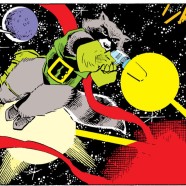Guest Review – Rocket Raccoon 1985 series
By Steven Hanks
With all the excitement surrounding the Guardians of the Galaxy film, and namely its diminutive star, I thought it would be fun to go back and examine his humble beginnings and re-read the first full mini-series featuring everyone’s favorite genetically altered alien. It is time to go back to the Keystone Quadrant and weave our way through the wonders of Halfworld. Join me on this journey by whatever means you like. Me, I’ll be trying to hitch a ride on the Rack ‘n Ruin as we review the Marvel Limited Series from 1985 that gave the world it’s first, feature-length story starring the one and only Rocket Raccoon.
The self titled Rocket Raccoon four issue mini-series from 1985 was not our first look at Rocket. He was first mentioned as Rocky Raccoon in Marvel Preview #7 (featuring Satana) in 1976. Though that story allegedly takes place 10,000-15,000 years in the future, it is considered canon. In this incarnation, Rocket spouted a cockney accent and assisted a prince lost on the planet Hailailae. If you ever get a chance to read that story, it is interesting that it also features an animated “tree” that Rocket claims had helped him catch food. Clear shades (or foreshadowing) of Groot.
After that, Rocket made an appearance by mention at the end of Incredible Hulk #270 and then as an actual part of the adventure in Incredible Hulk #271-#272. Now, this article is meant to be a review of the mini-series and not be a history of Rocket Raccoon. However, the Incredible Hulk story is directly related to, and referenced in, the 1985 mini-series, thus it begs mention before we get started.
The Rocket Raccoon limited series starts by introducing the reader to the subtleties of the Keystone Quadrant and an explanation of the role of Ranger Rocket on the planet Halfworld. It is Rocket’s job to help care for the residents of Halfworld (the “loonies”) by investigating crimes and serving as chief law enforcement officer of the insane asylum-like colony. The loonies were abandoned on the primitive world, left with only robots to care for them. How the “animals” got involved is explained later in the story arc. This is a far cry from the intergalactic outlaw that we know today as Rocket Raccoon.
The story starts out with many details that the casual reader may interpret as silly, or perhaps not proper fare for a serious comic book reader. In reality, nothing could be further from the truth. The characters may be fun, with talking animals with names like Wal Rus, the Keystone Cops and killer clowns, but one has to delve a little deeper and see that Bill Mantlo is weaving a much more socially significant story than it would appear on the surface. No doubt, 1985 was a different time and there are plenty of politically incorrect references at the beginning of the tale. However, the reader will learn, by the time it’s all over, that what would seem insensitive by today’s standards actually served a higher purpose. Pay attention to this story, you might just learn something.
Mignola’s artwork is true fine-line bliss. This is high-definition art. Each hair is visible, each explosion has its own charisma, and each scene is laid out in simple perfection. The attention to detail is stunning. Care is given to every character whether they are in one frame or a dozen. This is pure 1980s graphic style, where backgrounds are as important as everything else in the composition. There is no wasted space or dead-zone in the panels. Mignola is a master.
The plot of Rocket Raccoon (1985) is that of a toy war between two rival toy makers/distributors. In the meantime, someone has kidnapped Rocket’s best girl and managed to steal Gideon’s Bible (the Bible of the ancient Shrinks). From there, action ensues and the conspiracies, betrayals, plot twists and surprises start to pile up. All the while, Rocket Raccoon keeps his focus on helping the loonies and seeking a true cure for their illness.
Oh, I can hear the naysayers ranting: Toy wars? Killer clowns? Talking animals? Sing-song, rhyming dialogue? A cloud of killer bad breath? How can this be deep writing? Where is the hardcore action and adventure that I have come to expect from the modern Rocket Raccoon? Where are the dead bodies, mechanical genius, reckless attitude, and famous, “Blam! Murdered you!”? Please don’t tell me that this is how his narrative actually begins, with bunnies, walruses and a girlfriend who is an otter!
Well, it is. Be sure, this Rocket is our Rocket! Long before the tagline, this is the true foundation of Rocket Raccoon. Don’t let the bright colors and fun atmosphere fool you. The bodies are dropping and the theme of this story is deadly serious. Further, it ends as every good origin story should, with our hero achieving his dream and venturing out into the galaxy for even more adventures; the adventures that have come to further define our favorite “creepy little beast.”
If all you take away from this story is the adventure, please stop reading now and also stop reading comics altogether. Rocket Raccoon (1985) is much more than a simple, seemingly silly story. It is a commentary on the treatment of the mentally ill and the responsibility that we, as fellow living beings, have to ensure that those with such illnesses are treated with dignity and respect. In 1985, it took a genetically altered alien who looks like a raccoon to teach us that the diseases of mental health are treatable and that these people are not the throw-aways of society. More than that, Rocket Raccoon tells a human story that addresses the often hidden and forgotten horrid tradition of mental health treatment in society. Maybe it took some talking animals and outrageous art to encourage us to take a look at ourselves and acknowledge our faults and shortcomings when it comes to helping those with stigmatizing illnesses.
While the Keystone Quadrant, and the planet of Halfworld, may seem to be far removed, secured behind a dyson-sphere-like shield, in some crazy corner of another reality, know this, it has firm foundations in the Marvel Universe. The Hulk is mentioned as having already encountered Rocket during a recent adventure. And upon close examination, the uniforms of the Shrinks bear more than a passing resemblance to other uniforms in the Marvel Universe. Halfworld is further mentioned in modern canon, specifically in Rocket Raccoon #2 (2014) by Young and Beaulieu. Even today, Halfword is not dead. But as for the 1985 series, there may be additional planned and unplanned Easter Eggs in the bizarre forests of this strange planet. Only the trained eye, versed in the traditions of Marvel lore, will be able to pluck some of those out of the background.
Thirty years ago, Bill Mantlo and Mike Mignola gave us a story that holds up well and can serve to teach us something to this day. The writing and artwork are second to none. Beyond that, they gave us Rocket Raccoon, a fun, enigmatic and diverse character that has had numerous interpretations over the years. Far removed from Halfworld, Rocket has forsaken his loving Lylla and taken to questing throughout the galaxy alongside his friend Groot and his allies in the Guardians of Galaxy. We all have our start somewhere, and Rocket’s start was in a humble limited series in 1985. It was an age when the world was threatened with war, the environment was in tatters, and mental health was a volatile topic. It was a world much like it is today. Perhaps now, just like then, we need Rocket Raccoon.








Sounds fun! I added it to my Marvel Unlimited reading list:)